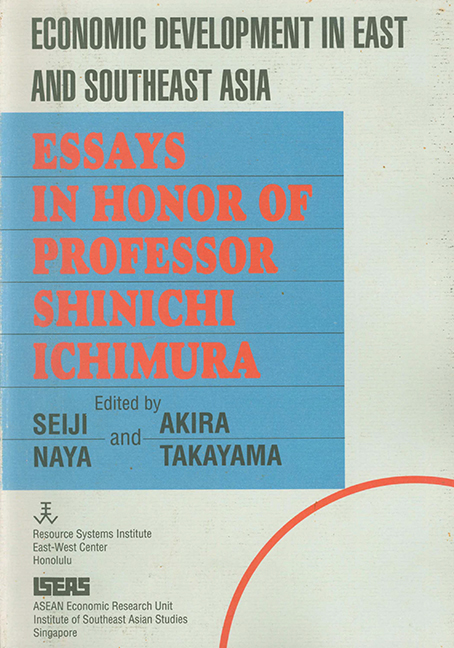Book contents
- Frontmatter
- Preface
- Shinichi Ichimura, 1925-
- CONTENTS
- Introduction
- Contributors to This Volume
- I Structural Change and Economic Development in Developing Asia in the 1990s
- II Explaining the Success of the Four Little Dragons: A Survey
- III Taiwan's Economic Miracle: A Singaporean Perspective
- IV Singapore's Experience of Industrial Restructuring: Lessons for the Other Asian NIEs
- V Korean Industrial Policies for Declining Industries
- VI Vietnam: Recent Economic Developments and the World Economy
- VII Transition from Import Substitution to Export Expansion: The Thai Experience
- VIII Adjustment Problems of a Small Oil-Exporting Country: Did Indonesia Suffer from the Dutch Disease?
- IX A Quarterly Econometric Model of the Hong Kong Economy
- X The Effect ofRicardian Rent Extracting on Macroeconomic Performance
- XI Direct Foreign Investment and the Economic Development of Korea
- XII Japanese Investment in Thailand: Looking Back and Into the Future
- XIII The Effects of Direct Foreign Investment on Taiwan: A Macroeconometric Investigation
- XIV A Reform of the Foward Foreign Exchange Market and Foreign Exchange Rate Determination Policy in Korea, with Foreign Exchange Policy Experiences of Taiwan
- XV Interest Rate and Foreign Exchange Liberalization in Taiwan in the 1980
- XVI Manifold Dilemmas behind External Debt Management
- XVII Agricultural Growth and Food Imports in Developing Countries: A Reexamination
- XVIII The Transformation of Rural Asia and Economic Development Theory and Policy
- XIX The ASEAN Summit and ASEAN Economic Cooperation
- XX The Role of Developing Countries in the New GATT Round
- XXI The Emerging Global Economy and the Role of the Asian NIEs
- Index
I - Structural Change and Economic Development in Developing Asia in the 1990s
Published online by Cambridge University Press: 21 October 2015
- Frontmatter
- Preface
- Shinichi Ichimura, 1925-
- CONTENTS
- Introduction
- Contributors to This Volume
- I Structural Change and Economic Development in Developing Asia in the 1990s
- II Explaining the Success of the Four Little Dragons: A Survey
- III Taiwan's Economic Miracle: A Singaporean Perspective
- IV Singapore's Experience of Industrial Restructuring: Lessons for the Other Asian NIEs
- V Korean Industrial Policies for Declining Industries
- VI Vietnam: Recent Economic Developments and the World Economy
- VII Transition from Import Substitution to Export Expansion: The Thai Experience
- VIII Adjustment Problems of a Small Oil-Exporting Country: Did Indonesia Suffer from the Dutch Disease?
- IX A Quarterly Econometric Model of the Hong Kong Economy
- X The Effect ofRicardian Rent Extracting on Macroeconomic Performance
- XI Direct Foreign Investment and the Economic Development of Korea
- XII Japanese Investment in Thailand: Looking Back and Into the Future
- XIII The Effects of Direct Foreign Investment on Taiwan: A Macroeconometric Investigation
- XIV A Reform of the Foward Foreign Exchange Market and Foreign Exchange Rate Determination Policy in Korea, with Foreign Exchange Policy Experiences of Taiwan
- XV Interest Rate and Foreign Exchange Liberalization in Taiwan in the 1980
- XVI Manifold Dilemmas behind External Debt Management
- XVII Agricultural Growth and Food Imports in Developing Countries: A Reexamination
- XVIII The Transformation of Rural Asia and Economic Development Theory and Policy
- XIX The ASEAN Summit and ASEAN Economic Cooperation
- XX The Role of Developing Countries in the New GATT Round
- XXI The Emerging Global Economy and the Role of the Asian NIEs
- Index
Summary
Introduction
As the year 2000 approaches, interest in the economic prospects for the world economy, and Asia in particular, has quickened. A number of studies of developing Asia have been undertaken for the 1990s both by national governments (e.g., Korea and Philippines) and by multilateral agencies (e.g., Asian and Pacific Development Centre). This paper has been developed with the primary purpose of analyzing the structural changes that are likely to take place in the Asian developing countries over the next decade and the implications this will have for public investment needs (particularly development assistance), international trade, and the balance of payments.
The level of foreign assistance required by the developing countries of the region will depend critically upon both domestic and external balance, which in turn will depend upon a number of factors, including the effectiveness with which the developing countries can mobilize savings, improve efficiency, and promote exports. By exploring a scenario for growth and structural change, it is hoped that this paper will make a small contribution to the continuing discussion on the future of developing Asia.
In order to develop some perspectives for the future, it is important to review the past performance of these countries. Following this review a set of baseline projections for the 1990s is developed. These projections are point estimates representing my view of the most likely scenario. Due to time and space constraints, no attempt is made to derive a set of high and low scenarios for each country. The paper concludes with a discussion of some of the projected growth in terms of structural change, trade patterns and development strategy.
World Economic Developments, 1970—87
The sequence of international events of the past decade and a half and the uncertainties which they have created for economic planners and forecasters are familiar. However, a short summary of these events is nevertheless useful in framing a view as to the future prospects of the world economy and of Asian developing countries in particular.
From 1970 to 1987, the world economy recorded an annual average growth rate of 2.8 percent. Industrial countries expanded by 2.6 percent annually, while developing countries grew by 3.3 percent annually. Among the developing countries, Asia recorded the best performance, growing by more than 6 percent a year.
- Type
- Chapter
- Information
- Economic Development in East and Southeast AsiaEssays in Honor of Professor Shinichi Ichimura, pp. 1 - 19Publisher: ISEAS–Yusof Ishak InstitutePrint publication year: 1990

